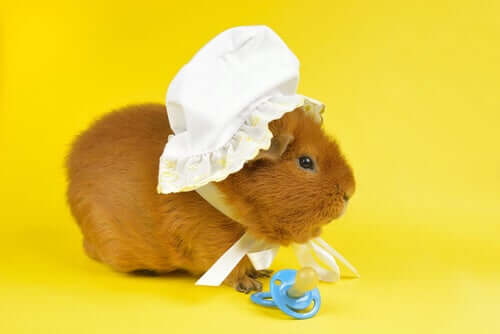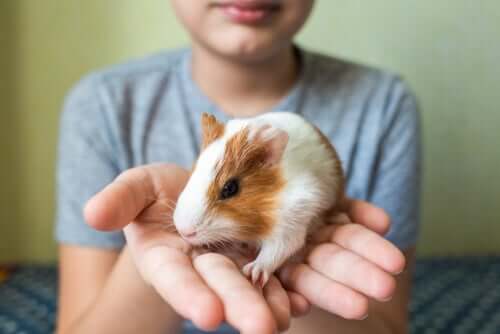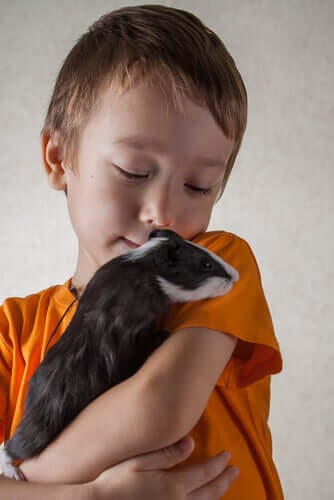How to Tame a Guinea Pig: Tips and Tricks

If you’re wondering how to tame a guinea pig, that will depend a lot on its individual personality. Guinea pigs are naturally skittish in unfamiliar situations, because they typically end up being prey in their own habitat. This sometimes causes them to react strongly when they feel like they’re in danger.
This is especially true with guinea pigs who haven’t been socialized from the time they were babies. So, if you buy one from a “home” breeder, it’s usually friendlier and less anxious than one you get in a pet store.
Some get skittish and nervous around people. That means that, for its happiness and yours, it’s important for you to take some time out to tame your guinea pig.
How to tame a guinea pig
Before you start trying to tame a guinea pig, you should create a link between its favorite treats and you. Fresh greens and small pieces of fruit are a perfect example. Your guinea pig will have a hard time saying no to those!
At the beginning of each session, take any toys or other obstacles out of the cage or living space. The idea is to make sure it doesn’t have a hiding place ready. You don’t want anything to interfere during this time. That will also help keep the guinea pig focused on you and the tasty treat waiting for it.
Establish familiarity with a treat
Start by walking by your guinea pig’s cage or living space a few times a day. Use a soft voice while you organize the cage or put water and food inside it. During this phase, don’t try to touch or pick up your guinea pig.

Once the guinea pig has gotten used to you being near it, offer it a treat while you speak softly to it. If it takes the treat from your hand, you can keep going. If it seems scared and won’t take the treat from you, back off and keep the treat.
Build trust
Repeat that process with the treats a few times a day until it comes and takes the treat. This phase usually lasts a week or more, so you should be patient. Guinea pigs generally get over their reservations pretty quickly and will come to you for food before long.
You might also notice that offering treats before you put its normal food in the cage can help. But don’t leave treats in the cage for it to wait until after you’ve gone. Keep trying to feed it from your hand until it feels comfortable approaching you. Once it forms an association between you and the treat, it will come running every time.
Pet it
Now that your guinea pig is happy to eat a treat from your hand, you can start to pet it softly. Start with one finger, and lightly stroke its back. Don’t raise your hand above it, because that could end up scaring it.
Once your guinea pig is happy to let you pet it, you can pick it up and take it out of its cage. Hold it in your arms and give it another treat. Pet it gently and speak softly to it while it munches on its tasty treat.

You want this experience to be a positive one for it. Once again, this is all about it associating the good treatment with receiving its favorite kind of food. Repeat the process a few times a day until it feels comfortable being held by you. But never let the sessions go on any longer than 10 minutes at a time.
Tips on how to hold a guinea pig
One major part of learning to tame a guinea pig is to know how to hold it properly. This is extremely important because you could scare it or hurt it if you don’t hold it properly.
When you want to pick it up, put your right hand over its shoulders. Don’t press down. Then put your thumb behind its front paws. After that, put one or two fingers in front of its back packs and the other fingers behind them. Finally, put your left hand under its belly so that it has complete support.
Be careful
Pick up your guinea pig sideways, making sure not to let its back paws hang. If it squirms or fights you, keep its back paws still with your left hand. Try not to hold it vertically, because that could hurt its back.
Once you’ve picked it up off the ground, nestle it close to your chest. That will help to make sure it feels safe and protected, and keep it from getting panicked.
If your guinea pig seems fidgety after you’ve been holding it for a few minutes, it might need to urinate. Always let it down if it’s squirming so that it doesn’t get stressed or feel uncomfortable. Guinea pigs are very sensitive to the moods of their owners, so if you get nervous and try to rush things, you probably won’t be able to tame yours.
All cited sources were thoroughly reviewed by our team to ensure their quality, reliability, currency, and validity. The bibliography of this article was considered reliable and of academic or scientific accuracy.